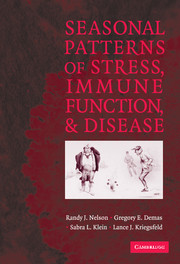Book contents
- Frontmatter
- Contents
- Acknowledgments
- Foreword
- Preface
- 1 Seasonality
- 2 Immune Function
- 3 Seasonal Fluctuations in Disease Prevalence
- 4 Seasonal Changes in Immune Function
- 5 Photoperiod, Melatonin, and Immunity
- 6 Energetics and Immune Function
- 7 Hormonal Influence on Immune Function
- 8 Clinical Significance of Seasonal Patterns of Immune Function and Disease
- References
- Index
2 - Immune Function
Published online by Cambridge University Press: 11 November 2009
- Frontmatter
- Contents
- Acknowledgments
- Foreword
- Preface
- 1 Seasonality
- 2 Immune Function
- 3 Seasonal Fluctuations in Disease Prevalence
- 4 Seasonal Changes in Immune Function
- 5 Photoperiod, Melatonin, and Immunity
- 6 Energetics and Immune Function
- 7 Hormonal Influence on Immune Function
- 8 Clinical Significance of Seasonal Patterns of Immune Function and Disease
- References
- Index
Summary
Self-defence is Nature's eldest law.
John Dryden, 1695 Absolom and AchitophelIntroduction
During evolution, the cells of multicellular organisms began to specialize in function to achieve a common goal of replicating shared genetic material to place into offspring. Cells within these multicellular organisms developed specific markers to identify them as part of the organism. The evolution of self-recognition molecules was likely a response to single cell organisms that began to specialize in exploiting the resources of the larger individuals for their own survival and reproductive needs (Hamilton et al. 1990). The fundamental feature of any defense against parasitism is the ability to recognize “self” from “non-self”. During the course of evolution, increasingly elaborate methods have developed among parasites, bacteria, viruses, and fungi to “trick” or override the defenses of multicellular individuals to exploit their resources. In other words, these pathogens have evolved mechanisms to mimic or supersede the self signals of the host individuals. The bodies of the host individuals are the “homes” and “meals” for parasites, so parasites have evolved mechanisms to elude host defenses (Nesse & Williams 1994). In response, hosts have evolved intricate defenses against the presence of bacteria, viruses, parasites, and fungi. Immune (from the Latin, immunis = free from) responses have developed that can neutralize these pathogens. Many host defenses are very energetically costly, for example, regeneration of tissue to maintain the skin or maintenance of high body temperature during fever. As noted in the previous chapter, the energetic costs of these defense strategies are optimized in relation to the energetic costs of other physiological processes. Seasonal fluctuations in energy availability and requirements form the basis for seasonal fluctuations in immune function and disease processes.
- Type
- Chapter
- Information
- Publisher: Cambridge University PressPrint publication year: 2002
- 1
- Cited by



